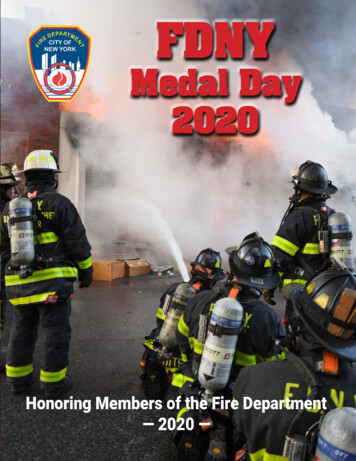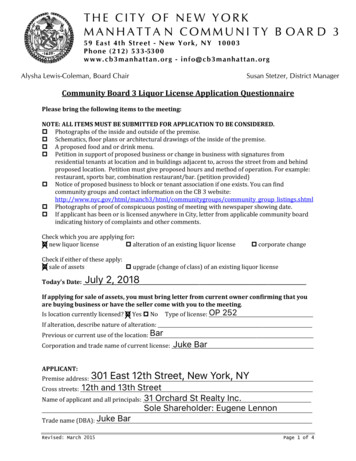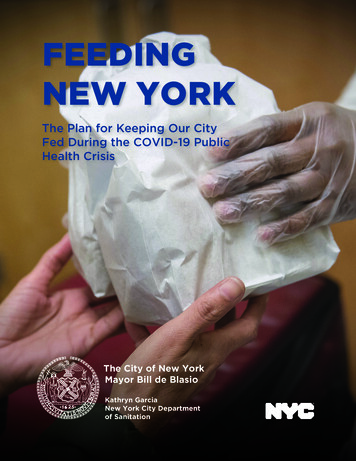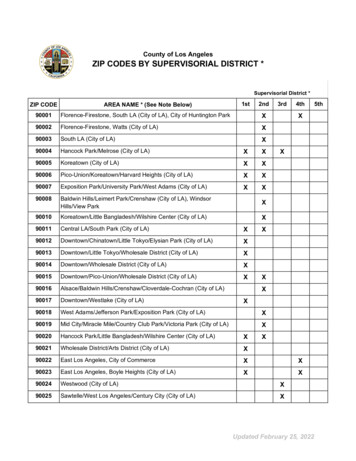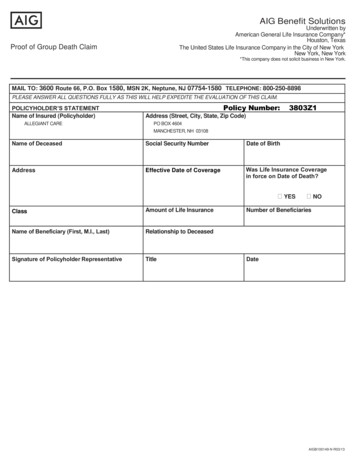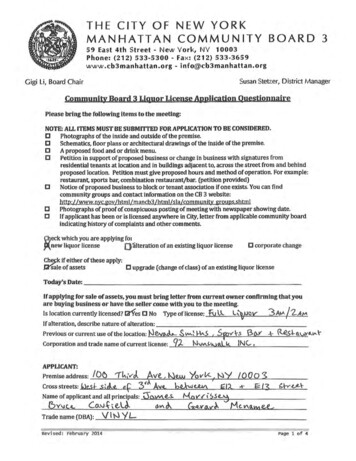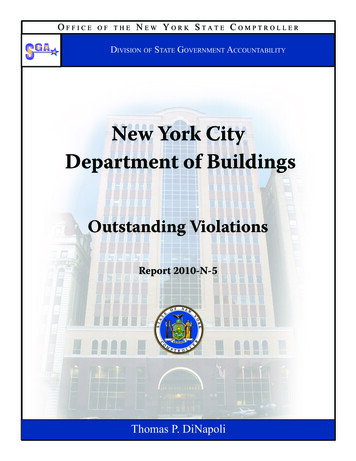
Transcription
Officeof theNew York State ComptrollerDivision of State Government AccountabilityNew York CityDepartment of BuildingsOutstanding ViolationsReport 2010-N-5Thomas P. DiNapoli
This page is left intentionally blank.
Table of ContentsPageAuthority Letter. 5Executive Summary. 7Introduction. 9Background. 9Audit Scope and Methodology. 9Authority . 11Reporting Requirements. 11Contributors to the Report . 11Audit Findings and Recommendations. 13Violations Not Re-Inspected Timely. 13Recommendations. 14Verifying Property Owner Claims. 15Recommendations. 16Agency Comments. 17State Comptroller’s Comment. 19Division of State Government Accountability3
This page is left intentionally blank.
Authority LetterState of New YorkOffice of the State ComptrollerDivision of State Government AccountabilityDecember 1, 2011Robert D. LiMandriCommissionerNew York City Department of Buildings280 Broadway, 7th FloorNew York, NY 10007Dear Commissioner LiMandri:The Office of the State Comptroller is committed to helping State agencies, public authoritiesand local government agencies manage government resources efficiently and effectively and,by so doing, providing accountability for tax dollars spent to support government operations.The Comptroller oversees the fiscal affairs of State agencies, public authorities and localgovernment agencies, as well as their compliance with relevant statutes and their observanceof good business practices. This fiscal oversight is accomplished, in part, through our audits,which identify opportunities for improving operations. Audits can also identify strategies forreducing costs and strengthening controls that are intended to safeguard assets.Following is a report of our audit of New York City Department of Buildings’ OutstandingViolations. This audit was performed pursuant to the State Comptroller’s authority as set forthin Article V, Section 1 of the State Constitution and Article III of the General Municipal Law.This audit’s results and recommendations are resources for you to use in effectively managingyour operations and in meeting the expectations of taxpayers. If you have any questions aboutthis report, please feel free to contact us.Respectfully submitted,Office of the State ComptrollerDivision of State Government AccountabilityDivision of State Government Accountability5
This page is left intentionally blank.
Executive SummaryState of New YorkOffice of the State ComptrollerEXECUTIVE SUMMARYAudit ObjectiveThe objective of our audit was to determine whether managers at the New York City Departmentof Buildings (Department) assure timely follow-up on immediately hazardous buildingviolations that put the health and safety of the public at risk.Audit Results – SummaryBuilding code violations are serious and can often jeopardize people’s health, safety, propertyand even their lives if left uncorrected. Class 1 violations are the most serious and must becorrected immediately, often to avoid endangering a significant number of people or the publicat large. However, we found Department managers do not have effective systems in place toensure hazardous violations are resolved quickly. As a result, they are allowing some Class 1violations, which represent the most immediate and severe threat to life and safety, to remainopen for as long as six months before following up to see if the problems have been corrected.In the meantime, these delays are placing the public at risk. Examples include a building inManhattan cited for an air conditioner blocking the entrance to a fire escape. Inspectors didnot return for more than six months to follow-up, at which time they found the air conditionerhad yet to be moved. In another case, inspectors found a partial roof collapse in Queens thatremained uncorrected after more than four months.The law requires the Department to re-inspect all Class 1 violations within 60 days if theowner has not filed a Certificate of Correction indicating problems have been fixed. However,Department managers do not even begin scheduling re-inspection of these open violationsuntil the fourth month following the citation. Our review of 1,206 open violations written inApril 2010 and scheduled for re-inspection during August showed that 1,063 re-inspectionswere performed. Of the 1,063, 94 percent of inspections did not actually occur until the fourth,fifth or sixth month. Department officials explained that limited resources and other safetypriorities have prevented their inspectors from conducting timely re-inspections.Further, when these inspections took place, almost half of the time (47 percent) inspectorsfound the conditions had not been corrected and continued to pose an immediate threat tolife and safety. In another 12 percent of these cases, inspectors were not able to gain access tothe buildings to perform the inspection and could not determine if corrections had been made.Division of State Government Accountability7
In these cases, they simply left a notice for the owner asking that they call in and schedule anew visit. Department managers do not automatically schedule any additional follow-up if theowner does not comply.Since 2002, the Department has had a program to test the reliability of the Certificates ofCorrection by re-inspecting a sample of cases. During the first half of 2010, the Departmentselected 2,607 cases for verification. However, at the beginning of December 2010, one-fourthof these inspections had still not been done; half because inspectors did not gain access to thebuilding on their initial visit and the other half simply because they had not yet been scheduled.For the three-fourths of these inspections that were done, the Department found 91 percentof the owners’ Certificates of Correction were accurate and violations had been corrected.However, for seven percent, inspectors concluded they were false and the hazardous conditionscontinued. Still, inspectors only issued new violations related to these false certifications inabout half of the cases. Managers did not provide specific explanation of why no further actionwas taken against the other owners who falsely claimed to have corrected these dangerousproblems. Instead, they noted that most of them were older violations originally issued duringa time that did not provide for a second violation to be issued for false certification. Theyfurther explained that a new selection system was implemented in January 2011, which theybelieve will help better target higher risk certifications.Improving the inspection system is not only vital to public safety, but can also impact propertytransfers because violations must be corrected before a new or amended Certificate ofOccupancy can be issued. When a building cited for a Class 1 violation is not re-inspected, theDepartment cannot be assured that the violation was actually corrected and that the buildingis, in fact, safe for occupancy.Our report contains four recommendations for improving the Department’s follow-up onimmediately hazardous violations that remain outstanding. Department officials agreed withour recommendations and stated that they have taken steps to improve this oversight.This report dated December 1, 2011, is available on our web site at http://www.osc.state.ny.us.Add or update your mailing list address by contacting us at: (518) 474-3271 orOffice of the State ComptrollerDivision of State Government Accountability110 State Street, 11th FloorAlbany, NY 122368Office of the New York State Comptroller
IntroductionIntroductionBackgroundThe New York City Department of Buildings (Department) is responsiblefor ensuring the safe and lawful use of over 950,000 buildings andproperties located throughout the five boroughs. These buildings aresubject to various sections of the New York City Building Code and theRules of the City of New York.The Department’s Enforcement unit conducts inspections and isresponsible for ensuring that buildings comply with all applicable laws.When an Enforcement inspector discovers violations, the responsibleparty is cited. The most common type of citation issued is called anEnvironmental Control Board Notice of Violation (violation). There arethree classes of violations: Class 1 (immediately hazardous), which presents a severe threat tolife and which must be corrected immediately Class 2 (major violation), which must be corrected within 40 days Class 3 (lesser violation), which corresponds to the formerclassification of “non-hazardous,” and also must be corrected within40 daysViolations contain an order for the property owner to correct the violatingcondition and submit a Certificate of Correction to the Department.When a Class 1 violation is issued, the law requires the Department tore-inspect the property within a specified time period if a Certificate ofCorrection is not filed.According to the February 2010 Mayor’s Management Report, theDepartment issued 63,575 violations between July 1, 2008 and June 30,2009 (fiscal year 2009) and 76,870 in fiscal year 2010. The Departmentdatabase shows 57,338 Class 1 violations issued during the period of July1, 2008 through August 4, 2010.Audit Scope andMethodologyOur audit determined whether managers at the Department assure timelyfollow up on hazardous building violations that put the health and safetyof the public at risk. Our audit scope period was July 1, 2008 throughDecember 14, 2010.Division of State Government Accountability9
We met with Department officials to gain an understanding of theirpractices for re-inspections of outstanding violations. We reviewedDepartment policies and procedures, including the Hazardous Reinspection Program manual and the Certificate of Correction AuditProgram protocol. We reviewed a random sample of 50 violations selectedfrom the database of 57,338 Class 1 violations issued from July 1, 2008through August 4, 2010. We reviewed a database containing violationsscheduled for re-inspection for the month of August 2010, and reviewedthe Certificates of Correction selected for audit by the Department fromJanuary 1, 2010 through June 30, 2010.We conducted our performance audit in accordance with generallyaccepted government auditing standards. Those standards require that weplan and perform the audit to obtain sufficient, appropriate evidence toprovide a reasonable basis for our findings and conclusions based on ouraudit objectives. We believe the evidence obtained provides a reasonablebasis for our findings and conclusions based on our audit objectives.In addition to being the State Auditor, the Comptroller performs certainother constitutionally and statutorily mandated duties as the chief fiscalofficer of New York State. These include operating the State’s accountingsystem; preparing the State’s financial statements; and approving Statecontracts, refunds, and other payments. In addition, the Comptrollerappoints members to certain boards, commissions and publicauthorities, some of whom have minority voting rights. These dutiesmay be considered management functions for purposes of evaluatingorganizational independence under generally accepted governmentauditing standards. In our opinion, these functions do not affect ourability to conduct independent audits of program performance.As is our practice, we notify agency officials at the outset of each audit thatwe will be requesting a representation letter in which agency managementprovides assurances, to the best of their knowledge, concerning therelevance, accuracy and competence of the evidence provided to theauditors during the course of the audit. The representation letter isintended to confirm oral representations made to the auditors and toreduce the likelihood of misunderstandings. In the representation letter,agency officials assert that, to the best of their knowledge, all relevantfinancial and programmatic records and related data have been providedto the auditors. Agency officials further affirm that either the agency hascomplied with all laws, rules, and regulations applicable to its operationsthat would have a significant effect on the operating practices beingaudited, or that any exceptions have been disclosed to the auditors.However, officials at the New York City Mayor’s Office of Operations haveinformed us that, as a matter of policy, mayoral agency officials will not10Office of the New York State Comptroller
provide representation letters in connection with our audits. As a result,we lack assurance from agency officials that all relevant information wasprovided to us during the audit.AuthorityWe did this audit according to the State Comptroller’s authority in ArticleV, Section 1 of the State Constitution and Article III of the GeneralMunicipal Law.ReportingRequirementsA draft copy of this report was provided to Department officials for theirreview and comment. Their comments were considered in preparing thisreport and are included at the end of this report.In their response, Department officials agreed with our recommendationsand stated that they have taken steps to improve its oversight.Within 90 days after final release of this report, we request that theCommissioner of the New York City Department of Buildings report tothe State Comptroller, advising what steps were taken to implement therecommendations contained herein, and if the recommendations werenot implemented, the reasons why.Contributors tothe ReportMajor contributors to this report include David R. Hancox, John Buyce,Walter Irving, Christine Chu, Jeremy Mack, Carole LeMieux, LillianFernandes and Sue Gold.Division of State Government Accountability11
This page is left intentionally blank.
Audit Findings and RecommendationsAudit Findings and RecommendationsViolations NotRe-InspectedTimelyBuilding code violations are serious and can often jeopardize people’shealth, safety, property and even their lives if left uncorrected. Class 1violations are the most serious and the law requires them to be correctedimmediately, often to avoid endangering a significant number of peopleor the public at large. A law requiring Class 1 violations to be re-inspectedwithin 60 days if the owner has not filed a Certificate of Correctionwent into effect on January 28, 2010. Previously, the Department wasrequired to re-inspect these properties within 120 days. We found theDepartment’s enforcement managers do not have effective systems inplace to ensure Class 1 violations are resolved quickly and re-inspectedin a timely manner. As a result, enforcement managers are allowingsome Class 1 violations to remain open for as long as six months beforefollowing up to see if the problems have been corrected.Each month, the Special Operations Unit receives a list of all openhazardous violations, excluding those violations involving the use oftechnical knowledge and must be followed up by the issuing units. SpecialOperations Unit inspectors are responsible for re-inspecting everyviolation on the list to determine whether the hazardous conditions stillexist. If it is found that the violation has not been corrected, additionalviolations are to be issued. We reviewed 1,206 open violations writtenin April 2010 and found that Department managers did not even beginscheduling re-inspection of these open violations until 120 days after theviolation; not 60 days, as required by the new law. In fact, 94 percent ofthese inspections were not even attempted until the fourth, fifth or sixthmonth.In the end, only 1,063 properties (88 percent) were actually re-inspectedbecause inspectors could not gain access to the other 143 locations.Inspection results are summarized in the following table. These violationsincluded faulty construction, illegal conversions (i.e., apartments that areseparated so landlords can rent out the same space to more people andmake more money), and faulty wiring.Division of State Government Accountability13
Number %9%100%Re-Inspection ResultNot CorrectedCorrectedWork in progressCould not gain accessOther (no longer applicable, etc.)TotalAs shown above, 572 violations (47 percent) had not been corrected andthe buildings continued to pose an immediate threat to life and safety. Inone of these instances, a building in Queens had been cited for a partialcollapse of its roof. Inspectors did not return to the site for more thanfour months, at which time they found the roof had yet to be repaired.In another case, inspectors originally cited a building in Manhattanwhen they found an air conditioner had been installed in a mannerthat blocked second floor access to the building’s fire escape. Wheninspectors returned more than six months later, the air conditioner hadstill not been moved.We also found Enforcement managers do not require inspectors to takeadditional measures to gain access to the property. When inspectorsare not able to gain access, they simply leave a form requesting that theproperty owner call the Department and schedule an appointment forthe re-inspection. However, there are no procedures in place for trackingthese forms or following up on re-inspections of these properties.To determine whether late re-inspections have been an ongoing problem,we randomly selected 50 out of 57,338 Class 1 violations that were issuedbetween July 1, 2008 and August 4, 2010 and reviewed when follow-upactions were taken. Of the 50 violations, 33 (66 percent) were still openand not resolved timely. Four of these cases had been open over 700 days.Department officials said that they developed a plan for re-inspectingClass 1 violations in October 2010. However, as of March 14, 2011, theDepartment has not fully implemented the re-inspection of all Class 1violations within 60 days. They also said that limited resources and othersafety priorities have prevented their inspectors from conducting timelyre-inspections.Recommendations 1. Communicate the plan for re-inspecting Class 1 violations to allEnforcement managers and inspectors and ensure properties are reinspected within the required 60 days.14Office of the New York State Comptroller
2. Establish procedures for following-up on cases where inspectorscould not access premises for re-inspections. Monitor compliance bystaff to ensure the follow-up inspections are done.VerifyingProperty OwnerClaimsSince 2002, the Department has had a program in place to test thereliability of Certificates of Correction by re-inspecting a sample of thosesubmitted. The Department’s Enforcement Analysis unit selected 2,607Certificates of Correction for re-inspection during the first six monthsof 2010. Of these, Enforcement inspectors visited 1,967 (75 percent)properties. As of December 2010, the remaining 640 properties (25percent) still had not been inspected; half because inspectors did notgain access to the building on their initial visit and the other half simplybecause they had not yet been scheduled.For the 1,967 properties that were re-inspected, the Department foundthat 1,799 (91 percent) of the owners’ Certificates of Correction wereaccurate and violations had been corrected. However, for 139 violations(7 percent), inspectors concluded the Certificates of Correction were falseand the hazardous conditions continued. Yet, inspectors only issued newviolations related to these false Certificates of Correction in just 77 of the139 cases (55 percent). Enforcement managers did not provide specificexplanation of why no further action was taken against the remaining 62owners who falsely claimed to have corrected these dangerous problems.Instead, they noted that most of them were older violations originallyissued during a time that did not provide for a second violation to be issuedfor false certification. They also indicated that certain circumstances maypreclude taking additional action against a building owner, such as anadministrative error or cases where the violation was issued to a previousowner.Department officials said that re-inspections in this program werenot always done due to understaffing or because other safety-relatedinspections were given a higher priority. Department officials alsoexplained that a new selection system was implemented in January 2011,which they believe will help better target higher risk certifications.Improving the inspection system is not only vital to public safety, butcan also impact property transfers because violations must be correctedbefore a new or amended Certificate of Occupancy can be issued. Whena building cited for a Class 1 violation is not re-inspected, the Departmentcannot be assured that the violation was actually corrected and that thebuilding is, in fact, safe for occupancy.Division of State Government Accountability15
Recommendations3. Complete all re-inspections for the Certificates of Correction listedin the monthly samples.4. Enhance the Certificates of Correction audit program by implementingthe automated selection system and completing the evaluation ofaudit results.16Office of the New York State Comptroller
Agency CommentsAgency CommentsDivision of State Government Accountability17
18Office of the New York State Comptroller
Comment*State Comptroller’s Comment* State Comptroller’s CommentAlthough the Department does not issue a Certificate of Occupancy automatically, they areissued upon the request of the property owners or finance companies who require them forthe transfer of property ownership.Division of State Government Accountability19
The New York City Department of Buildings (Department) is responsible for ensuring the safe and lawful use of over 950,000 buildings and properties located throughout the five boroughs. These buildings are subject to various sections of the New York City Building
